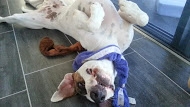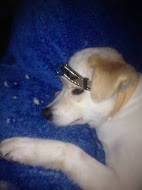
Browse Categories
- Dog Boot Camps
- Test
- Test
- Dogs Please Clicker Training
- Pet Insurance Comparison
- Exercising Pets With An E Scooter
- 10 Reasons Why Guinea Pigs Are Wholesome Little Pets
- Why You Should Use a Shed to House Your Pet
- How can Dog Owners Keep their Carpets Clean?
- How to Keep Your House in Order With Large Pets
- What is the Best Way to Feed a Puppy to Keep Them Healthy
- Pets Please
- All Animals and Pets
- Dogs and Puppies
- Cats and Kittens
- Birds
- Fish
- Reptiles
- All Other Small Pets
- Claws 'N' Paws Events
- PetsInLimbo/Greys4PetsInc.
News Search
PetsPlease News and Advice
Dogs Please Clicker Training WEEK 5

Week 5
Universal Lessons
Hi and welcome back.
As I have already mentioned I do not want to give you step by step instructions for everything that you are going to teach. I would rather you had a set of basic steps that will fit anything at all that you want your dog to know, then you can use the steps to teach anything at all.
A Dog Training Toolkit
A toolkit for training dogs is made up of more than treats and a clicker. It contains a foundation of knowledge that will help you to teach your dog anything at all. When you have a thorough understanding of how your dog learns then you have a fully functional mindset for training your dog. This is what I like to call a dog training toolkit.
Here are the most useful facts about how your dog learns;
1. A dog will repeat anything at all which brings him a favourable result, this can be attention, food, play or praise. Even negative attention will be seen, by most dogs, as a reward.
2. A dog will not repeat anything that he sees as pointless. So, if a behavior that he is experimenting is ignored or not reinforced by one of the above results then the dog will stop bothering with it and do something else instead. This is a natural behaviour often utilized on canine behavior modification. The result is called extinction and describes a result of extinct behaviour.
3. A dog will not effectively learn from the act of punishment which describes adding something to the situation after he has displayed a behaviour.
Hitting a dog is positive punishment and so is putting an aversive collar on him such as a prong collar with the aim of allowing him to pull then hurting his neck with the collar. Not only is this type of treatment frankly inhumane but they are used after the behaviour is carried out. Each time the dog displays a behaviour then he is practicing it.
True dog trainers do not do this, they set the dog up to succeed and reward the success whilst simultaneously providing no opportunity for failure, this is the way a dog learns best, the kindest approach.
I would like you to think about something that you would like to teach your dog. It can be something common like walking nicely on the leash or a specific trick that you would like him to learn. Ask yourself whether you have, so far, taken the above three points into account when trying to train your dog? Then try again but this time by following the points we have.
Now we have the dog training knowledge let’s look at the bare bones of teaching your dog anything at all, with the previous three points in mind. It is vital to keep distraction low when teaching anything new to train something new in a high distraction area is unfair and will probably fail, we will move on to handling distractions next week
Teach your dog anything at all – in logical steps;
Step One
Decide which of the clicker techniques you will be using to teach the behaviour that you want. Remember that you need to set your dog up to succeed so this first step should be really easy for him hence the need for a lure, capture or set of shaping clicks.
Step Two
Motivate your dog with something he really wants. Tiny tasty clicker treats will get his mind sharp and ensure keen learning. Deliver the treats quickly and repeatedly in the beginning, don’t allow the dog to get it wrong.
Step Three
Reward the behavior consistently until the dog has the idea what you want, then gradually drop off the reward as he learns. Remember reward builds confidence, motivation and even learning ability.
Step Four
After a few good displays of the behaviour that you are trying to teach, which should take no more than a few minutes, end the session on a good note.
Step Five
Carry out a few sessions over the next few days, then you can lose any lure, bring your command word forward and perfect the command. In the next session we will talk about proofing (increasing distraction) and using treats as variable rewards which will fit nicely onto the end of whatever you teach.
Here are some very simple examples of these steps at work;
Teaching a dog to come when called;
1. A lure and capture is good for this because you can lure the dog towards you with a treat and click as he gets to you.
2. In a quiet place in the home, or on the leash in a quiet area, show the dog a treat and say his name then as he comes to take it click and give him the treat.
3. Repeat step two a few times, calling the dog, giving the treat and telling him that he can go after he has eaten it
4. After five or six episodes of the dog coming back for a treat end the session and a particularly quick response from your dog.
5. Practice this until your dog knows the command word come, that when he does come he gets a click and a treat.
We will go into far more detail with this soon.
Teaching a dog to lie down;
1. Lure and capture as this is a simple position
2. Show the dog a treat and put it on the ground in front of him but keep your hand over it. The dog may try other behaviors but will eventually lie down, click and remove your hand from the treat. Tell your dog he can go as you give him the treat at this point, this is giving him permission to move and good practice for when we move on to more complicated things.
3. Repeat a few times, the dog will become quicker at lying down.
4. After a few times end the session on a good note and finish.
5. Practice, and bring the command word forward, yet still release your dog quickly, remember set him up to succeed and part of this is giving him permission to break a position before he decides it on his own.
A Command from Beginning to End
This week I would like you to decide on something that you want to teach your dog, something very simple, then choose a distraction free area and by following the steps above carry out a few training sessions whilst using the steps described above.
Remember that we are aiming, at this point, to build your dog’s confidence and your own. So keep things simple because next week we will be adding complications so your dog will need his confidence and so will you!
Have fun, enjoy your dog, remember to share your progress and we will see you soon.
Wednesday 22nd April 2015

